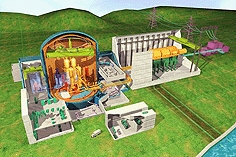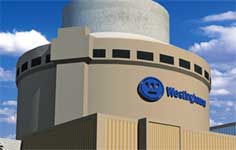The government’s announcement of reforms to the UK’s electricity market, designed to support the generation of low-carbon power, is likely to sound the starting pistol for utilities to begin making investment decisions for new nuclear build. Energy and climate change secretary Chris Huhne announced four reforms which, he claimed, represent the biggest shake-up of Britain’s energy market for the past 25 years.
Meanwhile, Areva, one of the two companies which has designs for new nuclear power stations in the Health and Safety Executive’s Generic Design Approval (GDA) process, said that it is on course to begin building the first of its new reactors in the UK, at Hinkley Point in Somerset, in 2012 — should EDF, the French utility which owns the site, decide to invest. ‘EDF have said that until they understand the market in which they will have to build the reactor and sell the electricity, they won’t be able to decide on investment,’ said Robert Davis, UK country director for Areva Nuclear Power. ‘[The reforms] are a major document to influence all the investors in new nuclear.’
Huhne’s reforms, worked out in conjunction with the Treasury, focus on four areas. To create long-term certainty on the cost of emitting CO2 from fossil fuels, the government will establish a carbon price floor. The government will also agree long-term contracts for low-carbon producers through a feed-in tariff, which will provide top-up payments to generators if wholesale prices are low, but will claw back money for consumers if prices rise higher than the cost of low-carbon generation.
Without investment in renewables, new nuclear and carbon capture and storage, emissions will remain too high
Chris Huhne
Huhne also announced that ‘reserve plants’ will be constructed, or demand reduction methods put into place, to create a ‘capacity mechanism’ to provide a safety cushion of capacity to make sure lights stay on as the amount of inherently intermittent low-carbon generation increases. Finally, an emissions performance standard will limit how much carbon the heaviest emitters — coal-fired stations — can put out, and will reinforce the existing requirement for carbon capture and storage readiness on all new coal-fired generation.
The system badly needed reforming, Huhne said. ‘More than £100billion of investment is needed in new power stations and grid upgrades over the next decade; that’s double the rate of the last ten years,’ he said. ‘Put simply, the current market is not fit to deliver this. Without investment in renewables, new nuclear and carbon capture and storage, emissions will remain too high. Low carbon technologies must be given the chance to become the dominant component in our electricity mix.’
If the industry has any reason to doubt the government’s long-term commitment, we could be facing a very real energy gap within a decade
Tom Foulkes, Director, ICE
Commenting on the reforms, the research director of the UK Energy Research Centre, Jim Skea, said that he was pleased the government had ‘grasped the nettle and proposed radical reform that takes on the challenges of low carbon, adequacy of investment, reliability and affordability.’ The director-general of the Institution of Civil Engineers, Tom Foulkes, sounded a note of caution, calling for a raft of further measures to increase investor confidence, such as a firming up of the energy policy statements and reassurance that the new planning system will assist progress. ‘If the industry has any reason to doubt the government’s long-term commitment, we could be facing a very real energy gap within a decade,’ he warned.
Areva is busy putting the final pieces into place for new nuclear build, while still working on the first four of its European Pressurised-water Reactors (EPR) at Olkiluoto in Finland, Taishan in China, and Flamanville in France. ‘The four EPRs we are building today will provide certainty and competence for UK projects,’ Davis said.
The first EPR, OL3 at Olkiluoto, has been hit by many delays during its construction, but is now in the final phases, with the reactor and three of the four steam generators now installed; the final build time is expected to total 86 months. However, Davis said, the experience of building the subsequent three EPRs is reducing this time. The Taishan reactors are expected to take 46 months to build. ‘China gives us new methodologies and new processes,’ Davis said. For example, the massive concrete base mat of OL3 was poured in one go, which caused significant problems; so much so that the Flamanville mat was poured in two sessions. ‘In China, we’ve been able to go back to a single pour with some clever use of heating and cooling, and that’s saved us four and a half months,’ Davis said. ‘Something like 50 percent of the engineers, managers, procurement and project people at Taishan have come from OL3. Both of these projects will finish in time for us to deliver projects in the UK; these people will pack their bags and come over to the new projects.’

The GDA, currently assessing the EPR design and Westinghouse’s competitor, the low-material-use AP1000 reactor, has suffered some delays as well, with two categories of the assessment — serious accidents and human factors — starting late because of a lack of resources at the HSE. However, the assessment is expected to reach a decision on granting interim design acceptance certificates (IDACs) in June 2011. ‘We believe we’ll be able to close out all the issues for the first EPR to be constructed at Hinkley Point,’ Davis said. Areva expects there will still be some outstanding issues when the IDAC is granted, ‘and we will have resolution plans in place for resolving these.’
Areva’s plans for the UK include four reactors for EDF and its partner, Centrica — two at Hinkley Point and two at Sizewell in Suffolk. It is also in commercial discussions with Horizon Nuclear Power, a joint venture between E.On and RWE nPower, to build two reactors at Wylfa in Wales and two at Oldbury in Gloucestershire. Another joint venture, NuGen, involving GDF Suez, Iberdrola of Spain, and Scottish and Southern Energy, has announced plans to build 3.6MW of new nuclear at Sellafield by 2023, and has also opened talks with Areva, Davis said.

Other generators have also welcomed Huhne’s proposals. Paul Godby, chief executive of E.On UK, said: ‘We believe that the picture looks positive for new investment in lower carbon generation, enabling clean to be built in preference to cheap. However, we need to look at the picture as a whole to ensure there are no unintended consequences for existing plant.’ For RWE nPower, chief executive Volker Beckers said: ‘I think that confidence will be boosted by today’s announcements, nevertheless this is a highly complex area and what is now important is to work through the details.’




Swiss geoengineering start-up targets methane removal
No mention whatsoever about the effect of increased methane levels/iron chloride in the ocean on the pH and chemical properties of the ocean - are we...